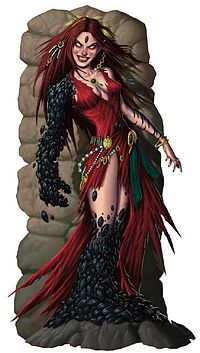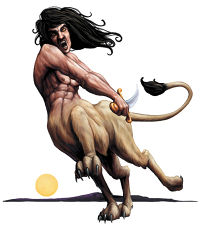On November 27th, 2022, the 8,000th article was added to the SuccuWiki!
Lamia (Dungeons and Dragons): Difference between revisions
mNo edit summary |
m (TeraS moved page Lamia (D and D) to Lamia (Dungeons and Dragons): Title change to match other D&D articles) |
(No difference)
| |
Latest revision as of 10:29, 16 March 2015
| Lamia | |
|---|---|
 Fourth-edition Lamia | |
| Characteristics | |
| Type | Magical beast |
| Image | Wizards.com image |
| Stats | Open Game License stats |
| Publication history | |
| Mythological origins | Lamia |
For the mythological being, see Lamia.
In the Dungeons & Dragons fantasy role playing game, the Lamia is a type of fictional monster. The lamia was formerly portrayed in the game as a creature with the lower body of a lion, and the upper torso, arms, and head of a human female. A less common type of lamia, the lamia noble, was depicted as having the lower body of a serpent. The lamia was introduced in the first edition Advanced Dungeons & Dragons game's original Monster Manual sourcebook, written by Gary Gygax and published in 1977. The lamia also appeared in second edition and third edition Dungeons & Dragons. In the fourth edition, it was reenvisaged as a swarm of insects.
Publication History
Advanced Dungeons and Dragons 1st Edition (1977-1988)
The lamia was first included in the original Advanced Dungeons & Dragons first edition Monster Manual (1977) by Gary Gygax. First edition AD&D game statistics and a description for the lamia appeared there, along with an illustration by David C. Sutherland III.[1] Published first edition Advanced Dungeons and Dragons adventures which included Lamia as adversaries that the players encounter included "The Ruins of Andril", published in Dragon #81.[2]
Dungeons and Dragons (1977-1999)
This edition of the D&D game included its own version of the lamia, known as the lamara, in Creature Catalogue (1986),[3] and the Creature Catalog (1993).[4]
Advanced Dungeons and Dragons 2nd Edition (1989-1999)
The lamia first appeared for second edition Advanced Dungeons & Dragons in the second volume of the Monstrous Compendium series (1989), with a black and white illustration.[5] The lamia's description and game statistics are reprinted in the Monstrous Manual (1993), with a color illustration by Jeff Butler.[6]
The lamia was detailed in Dragon #192 (April 1993), in the "Ecology (Love-Life) of the Lamia".[7] This article also described a relative of the lamia, the sa'ir.
Dungeons and Dragons 3rd Edition (2000-2007)
The lamia appears in the Monster Manual (2000) for the game's third edition, with a color illustration by Brian Despain.[8] The lamia also appears in the revised Monster Manual (2003) for edition 3.5, with the same illustration.[9]
The tigerus, a type of lamia, appears in Dangerous Denizens: The Monsters of Tellene (2003), for the Kingdoms of Kalamar setting.[10]
Dungeons and Dragons 4th Edition (2008-)
The lamia appears in the Monster Manual for this edition (2008), where it is described as a swarm of insects that inhabits the dead bodies of sentient fey (including elves, an elf-like race called eladrin, and gnomes), devouring their internal organs and using the hollowed-out bodies as a disguise. Every single insect in the swarm is formed from the devoured soul of a sentient being.[11]
Pathfinder
Lamia have also appeared in the Pathfinder Roleplaying Game, which was inspired by Dungeons & Dragons. The Pathfinder Roleplaying Game Bestiary describes lamia as "hate-filled inheritors of an ancient curse", and depicts them as lion/woman hybrids resembling those found in Dungeons & Dragons prior to its 4th edition. It mentions that serpentine, avian, and other forms of lamia also exist, but does not include game rules for them.[12]
Description
The first edition Monster Manual describes the lamia as having the upper torso, arms, and head of a human female, and the lower body of a beast. A lamia is chaotic evil under the game's alignment system.[1] Monstrous Compendium Volume Two describes lamias as "half-human, half-quadruped beast hybrids", and notes that while the upper part of a lamia is that of a beautiful human woman, its lower body is that of a beast such as a goat, deer, or lion, and they wear no clothing or jewelry.[5] The third edition Monster Manual does not mention a specific gender for the human portion of a lamia, and its accompanying illustration is that of a male lamia.[8] The 3.5 revised Monster Manual describes a typical lamia as being about 8 feet long and weighing about 700 pounds.[9]
Combat
The first edition Monster Manual notes that a lamia is "very fast and powerful", and usually armed with a dagger. A lamia has the ability to magically charm other creatures and use illusions, and it uses these abilities to lure creatures in the game and hold them in place while it devours them, first draining the prey of blood and then feasting upon its flesh. The book also notes that a lamia's touch permanently drains a creature's wisdom, eventually allowing it to completely control the prey.[1] According to Monstrous Compendium Volume Two, lamia may use illusions to make itself look like "a lovely damsel in distress, a tough but beautiful female ranger, or an elf maiden".[5]
Ecology
The first edition Monster Manual explains that lamias prefer to dwell in deserts, or places such as ruined cities or caves.[1] Monstrous Compendium Volume Two states that lamia "seem devoted to the spreading of chaos and evil in their dwelling places".[5] The third edition Monster Manual notes that lamia "take great pleasure in causing suffering", and that they "particularly target those who serve the cause of good for horrible deaths".[8]
Society
According to the first edition Monster Manual, a lamia is always encountered alone.[1] The third edition Monster Manual adds that lamia may also be encountered in pairs, or in small groups of up to four.[8]
Related Creatures
The lamia noble first appeared in the Fiend Folio (1981).[13] The lamia noble appears in the Monstrous Compendium Volume Two (1989),[5] and is reprinted in the Monstrous Manual (1993).[6] The lamia noble appears again in Expedition to the Demonweb Pits (2007).[14] The lamia noble is a rarer type of lamia. These beings rule over other lamias and the locations they inhabit. Unlike the more common type of lamia, they have the lower bodies of serpents. Males fight with curved swords and magic, while females only with magic. Lamia nobles are also capable of venturing further from their lairs than other lamias, and prefer to go into urbanized areas in the guise of a human to infiltrate human and demihuman societies. Lamia nobles are given to outbursts of senseless violence. They can speak all forms of human and demihuman language.
See also
References
- ↑ 1.0 1.1 1.2 1.3 1.4 Gygax, Gary. Monster Manual (TSR, 1977)
- ↑ Melluish, Ian (January 1984). "The Ruins of Andril: An AD&D adventure for 4-8 characters, levels 8-11". Dragon 8 (7): 41–56. TSR.
- ↑ Morris, Graeme, Phil Gallagher and Jim Bambra. Creature Catalogue (TSR, 1986)
- ↑ Nephew, John. Creature Catalog (TSR, 1993)
- ↑ 5.0 5.1 5.2 5.3 5.4 Cook, David, et al. Monstrous Compendium Volume Two (TSR, 1989)
- ↑ 6.0 6.1 Stewart, Doug, ed. Monstrous Manual (TSR, 1993)
- ↑ Jones, Spike Y. "The Ecology (Love-Life) of the Lamia" Dragon #192 (TSR, 1993)
- ↑ 8.0 8.1 8.2 8.3 Cook, Monte, Jonathan Tweet, and Skip Williams. Monster Manual (Wizards of the Coast, 2000)
- ↑ 9.0 9.1 Cook, Monte, Jonathan Tweet, and Skip Williams. Monster Manual, (Wizards of the Coast, 2003)
- ↑ Dangerous Denizens: The Monsters of Tellene. (Kenzer & Company, Wizards of the Coast, 2003)
- ↑ Mearls, Mike, Stephen Schubert, and James Wyatt. Monster Manual (Wizards of the Coast, 2008)
- ↑ (September 2009) “Monsters A to Z”, James Jacobs Bestiary, Lead designer Jason Bulmahn, Paizo Publishing.
- ↑ Turnbull, Don, ed. Fiend Folio (TSR, 1981)
- ↑ Baur, Wolfgang, and Gwendolyn F.M. Kestrel. Expedition to the Demonweb Pits (Wizards of the Coast, 2007)
